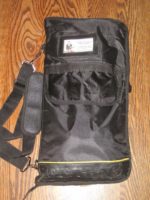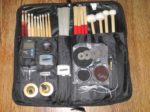John Stadtlander
What Do You Carry in Your Stick Bag?
Here’s a few thoughts about the drumsticks and other items that I carry with me to rehearsals and any gigs that I might be playing. I carefully consider what sticks, brushes or other things I need to get the required sound textures to convey the mood of any given song.
Some drummers only use drumsticks and never experiment with the many other types of beaters, sticks, rods, brushes etc., that are available to today’s drummer. These other types of beaters are important items to have in your bag if you are playing many different types of music.
Regardless of the implements you use, the first thing that any drummer should learn is how to play their instrument dynamically. If you can dynamically blend in with your fellow performers you have a better chance of landing future gigs. Dynamics are one of the best ways of adding mood to music and, when you are playing an instrument that has fewer tonal variations like the drum kit, being able to play over a wide dynamic range is a requirement. So learn and practice dynamics at every opportunity. When we add dynamics to our skills as well as using different drumsticks, brushes and other beaters to achieve different timbres and textures from our music, then we have an additional element to add to any musical situation.
So what’s in my stick bag…well the following items are essential as far as I am concerned. I will start with the “non-stick” items that I carry.
Firstly, I carry a metronome. When I am in a situation where it is critical that we start with the exactly correct tempo, or I am not as familiar with the song as I should be, I have my trusty metronome to help me. Regardless of whom I am performing with there always seems to be a song that the band struggles to start at the right pace. On such occasions I pull out the metronome which I set to run silently and I use the flashing LED’s as a visual cue to start the song…this insures that we get it right.
The metronome also helps me prepare for rehearsals. If I am learning a song from a CD, mp3 or from an online source, I always use my metronome to determine the tempo. That way when we are in the “rehearsal hall” I have an accurate tempo of the recorded version. I often find that live versions of songs quite often will be a little slower or faster depending on the arrangement being used or the feel that your band wants to get. With the metronome we can determine the actual tempo that suits us.
Secondly, I carry Moongel. Moongel is a small square of what looks like blue jello which I used to dampen any unwanted overtones on a drum. Usually I only use one square on my snare drum but sometimes other band members like a more dampened sound from the drums and, if I agree that the room acoustics need it, I will add some more to the other drums.
Drum keys are essential as well as other drum supplies like felts, snare straps or string and cymbal sleeves. If you are playing on ”the house kit” at a bar or the “backline” drum kit at a music festival, the drums and hardware are almost always well used (beaten up might be another term) and quite often the cymbal stands will have no plastic sleeves to protect either their or your precious cymbals. I carry a wide selection to ensure that my cymbals do not get “keyholed” from using the house cymbal stands.
I also carry a pair of “finger cymbals” when playing with one of my bands hence their inclusion in my stick bag.
Finally, one should always travel with ear protection. Depending on the band and the venue, you may need these for both practice and on stage situations.
Now to the various sticks that I carry.
I carry an array of traditional drums sticks sized 5A, 7A and some even thinner sticks. I carry one set of wood tipped sticks and the rest have nylon tips. I find that I play a lot in differing volume situations and I believe that the nylon tips give a slightly “brighter” ping to your ride cymbal to add some distinction over the underlying cymbal “wash”. The sticks with wood tips are used if I am looking for a “warmer” tone.
I also carry a pair of brushes with nylon or metal bristles. I have found that the nylon bristles generally have a more “mellow” sound than the usual wire brushes but I use both depending on the situation. Brushes are excellent in low volume situations using typical jazz taps and sweeps or just playing them in place of drumsticks.
I also carry two pair of “rods” in the lightest and next larger size. These give me a wide dynamic range and a softer sound than standard drumsticks.
Finally, I carry two pairs of timpani sticks. One pair is a traditional type with a regular handle while the pair with the smaller felt ends can be flipped to use the regular wooden drum tip on the other end. The tympani sticks are used on cymbals to get a “gong like” swelling sound or on the floor toms or my hand drum to get a lower deeper tone with less stick attack than a normal drumstick.
So that’s what I usually carry in my stick bag. One more thing of importance that I carry with me is a notebook. This allows me to take notes of what we are practicing. Also, if we are covering a lot of material in one rehearsal and I fear that it is too much for my mind to absorb and remember all at once, I will carry a small pocket recorder with me to rehearsal so I can review what we have covered at a later date.
I hope you found this information of interest and assistance.

